Dinger's Aviation Pages
The SS Fanad Head Incident
This page has been made possible by documents supplied to me by Geoffrey Halnan, who sadly died in July 2011. It is dedicated to the memory of all the brave men and women caught up in the events described. Other published works often give the wrong names for the participants or place them in the wrong aircraft. Invariably they give the impression that all three Skuas attacked at the same time and performed a dive-bombing attack. The following account is the true record of the amazing events of that day.
At the outbreak of World War Two, two Skua squadrons, 800 and 803, were in service on the British aircraft carrier HMS Ark Royal. The Ark was engaged in the blockade of Germany, patrolling between Norway and the UK to ensure no merchant ships slipped back to Germany and no U-boats or surface raiders broke out into the Atlantic. Only 11 days into the war, At 12.40 on 14th September 1939, the Ark Royal received a message that the SS Fanad Head was being chased by a surfaced U-boat at a position some 200 miles to the South West. The Fanad Head had left Montreal on the day war started, with a cargo of grain and eight paying passengers, bound for Belfast. Unknown to the British the U boat that was stalking her was the U-30 which had sunk the American Liner Athenia on the very first night of the war.
The Ark Royal sent two of her escorting destroyers, HMS Tartar and HMS Punjabi, to speed toward the aid of the Fanad Head. The Ark Royal then landed on her airborne aircraft and then followed. At 14.00, two more of her escorts, HMS Bedouin and HMS Eskimo were also sent ahead. At 14.40, the Ark Royal was close enough to launch aircraft, and three Skuas of 803 Squadron took off to go to the aid of the merchantman. They were each carrying a single 100 lb (45 kg) anti-submarine bomb in the fuselage recess and four small 24 lb (11 Kg) Cooper¹ bombs on the wing bomb racks. The Skua formation was led by the CO of 803 Squadron Lt Cdr Dennis Royle Farquharson Campbell, he had as his observer Lt Michael Charles Edward Hanson (later to be the navigator of the raid which sank the German cruiser Königsberg). They were in a Skua coded "A7A". Pilot Lt R.P. "Thirsty" Thurston and "Observers Mate " Petty Officer James "Jock" Simpson manned the second Skua L2873 coded "A7M", while pilot Lt Guy B.K. Griffiths and "Observers Mate" Petty Officer George Vincent McKay were in the third (L2957 "A7K")². The plan was for the Skuas to fly to the remote rocky islet of Rockall from where they would fan out in a search pattern to locate the Fanad Head. Two sub-flights of three Swordfish aircraft (six Swordfish in all), one from 810, Squadron led by Lt.Cdr. J. E. Fenton, RN and one from 821 Squadron, led by Lt M. G. W. Clifford, RN, were made ready to launch once the Skuas had located any target.
30 minutes after the Skuas had taken off, an alert lookout on the Ark Royal, (leading Signalman JE Hall) saw a torpedo track heading for the ship, his prompt warning enabled the Ark Royal to be turned in time to avoid destruction. The torpedoes were fitted with magnetic fuses designed to detonate close to their target and it has been suggested the ones used that day were defective; in any event, one of the torpedoes detonated in the wake of the Ark Royal, alerting her remaining escorting destroyers Faulknor, Firedrake and Foxhound. At once the escorts pounced and blasted the German submarine U-39 to the surface with depth charges. 43 Germans were rescued from the submarine before it sank, the first kill of a U-boat in World War Two. The Ark Royal had been lucky not to have been sunk. Just three days later the aircraft carrier HMS Courageous was sunk by a German submarine (U-29) with heavy loss of life. These events stopped the Royal Navy from using their carriers in the anti-submarine role until the advent, later in the war, of smaller escort carriers.
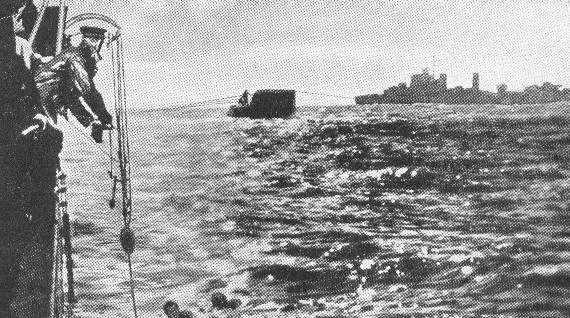
This dramatic picture appeared in British newspapers and magazines in 1939. It shows the sinking of the U-39 with the crew swimming towards the destroyer. The possibility that it showed the sinking of the U-35, which was also sunk by RN destroyers early in the war, was ruled out by Hans Mair. You can visit Han's excellent website about the U-35 at www.U-35.com
In the meantime, the three Skuas arrived at Rockall and then split up to search for the merchant ship. The SS Fanad Head had been chased by the surfaced U-boat U-30 since 11.00 hrs, and it was not until 12.25 hrs that warning shots caused the passengers and crew to take to the two lifeboats. The captain of the U-30, Fritz Julius Lemp, acted in an exemplary manner, towing one of the lifeboats clear of the ship and telling the passengers and crew that their SOS had been picked up and that a neutral American ship was on its way to rescue them. The U-boat then went alongside the SS Fanad Head and put aboard a party of 4 men (Oblt Z S Hisch, Ob Masch Burgen, Masch Mt Schmidt and Masch Ob Gefr Ohse) The U-boats log reveals that the intention was to obtain food and water to extend their patrol and to sink the ship by laying charges and opening seacocks, thus saving an expensive torpedo. This delay and the one-and-a-half-hour chase before the U-30 caught the Fanad Head, gave the Skuas time to cover the 180 miles (290 km) from the Ark Royal to the Fanad Head's position.

The SS Fanad Head, photographed from one of the lifeboats by Geoffrey Halnan.

This series of amazing photos show the Fanad Head as seen from the conning tower of the U-30. They were forwarded to me by Holger Oertel whose grandfather, Hermann Oertel, was a crewman on the U-30, then the U-101. These photos must have been taken only minutes before the first Skua attacked. One wonders what the lookout is observing through his binoculars. Perhaps he's caught sight of that first Skua?

View of the Fanad Head, you can see the lifeboats have been launched from their davits.
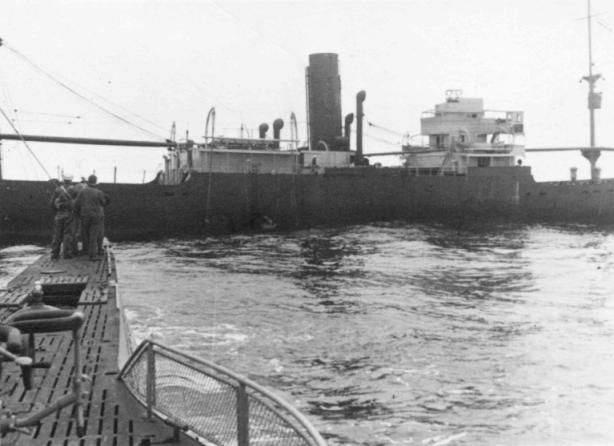
In this view, you can see a dinghy alongside the Fanad Head and figures are just visible on the deck of the Fanad Head, presumably the boarding party.
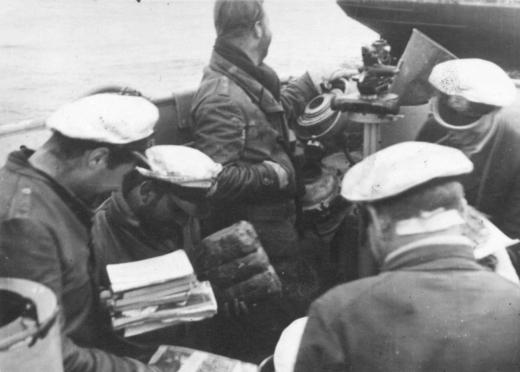
A conference on the conning tower of the U-30 with the stern of the Fanad Head just visible.
The photos above were sent to me by Holger Oertel, whose grandfather Hermann Oertel was a crewman on the U-30. They show a fairly relaxed scene as the U-boat crew reviews their prize.
It must have come as a huge shock when, so far from land, a British aircraft suddenly appeared. This was the Skua piloted by Lt R.P. Thurston. He swooped low to try to identify the merchant ship and was extremely surprised to suddenly be confronted by the U-boat close alongside. Making a split-second decision Lt Thurston dropped his bombs onto the submarine from an extremely low altitude, the only chance of catching the submarine before it could crash-dive. The small Cooper bombs would have exploded immediately on contact with the water, while the 100 Ib (45 kg) bomb, which had a 2-second delay after striking water, may have skipped along to explode close behind the Skua. Whatever the cause, fragments of shrapnel pierced the fuel tank and set the Skua on fire. Lt Thurston had to put the Skua down onto the sea a considerable distance from the ship. Badly burnt, Lt Thurston and P.O. Simpson set out to swim to the Fanad Head. The submarine had crash-dived to 30 metres (100 feet) but had left one of its crew, Ob Btsmt Hinisch, on the surface. The crewman swam to the safety of the Fanad Head. A rope from the rubber dingy used by the boarding party had become entangled with the submarine and the dingy was being dragged behind the submarine.
Lt Mike Hanson, the observer in the Skua piloted by Lt Cdr Dennis Campbell, spotted a ship in the distance. As the Skua turned to investigate they observed explosions around the ship. This was the attack by Lt Thurston and P.O. Simpson's Skua, but they interpreted it as the ship being shelled by the deck gun of a U-boat. Lt Hanson sent a contact report back to the Ark Royal in response to which the Ark launched the six Swordfish. When the second Skua arrived overhead the Fanad Head they spotted what looked like the conning tower of a submarine a mile south of the ship. Diving to attack, they made two passes, in the first they dropped their Cooper bombs and in the second the 100 lb (45 kg) anti-submarine bomb (which did not appear to explode). The object they attacked had disappeared. They flew around the Fanad Head and spotted two swimmers in the water - They interpreted this as two members of the crew of the U-boat left behind when it crash-dived. In fact, it was Lt Thurston and P.O Simpson, swimming toward the merchant ship. The object Lt Cdr Campbell and LT Hanson had attacked earlier was almost certainly the remains of their Skua floating on the surface. Then the real submarine surfaced. With no bombs left all they could do was open fire with their four front machine guns. This caused the submarine to promptly crash-dive again (but not before the crew had cut free the rubber dingy). Low on fuel, they radioed a report back to the Ark Royal and then flew over the lifeboats, flashing them the signal "Help Coming" by signal lamp before heading back to their carrier, on the way passing the two sections of Swordfish torpedo bombers dispatched to help (they had been launched at 16.55 hrs). When they landed back on the Ark Royal (at 18.16 hrs) they found holes in the fuselage caused by shrapnel from the Cooper bombs they had dropped.
Lt Thurston, badly burnt, had managed to swim perhaps as much as a mile (1,600 metres) to the side of the Fanad Head (an amazing feat in the cold waters of the Atlantic). By the side of the ship he passed out, but luckily he was spotted by the German boarding party and one of the Germans, Masch Ob Gefr Ohse, dived in to drag him to safety. This was even though Ohse himself had been badly injured by shrapnel from the Skuas bombs. Unfortunately, of P.O. "Jock" Simpson there was no sign. The U-boat surfaced again and manoeuvred alongside. Meanwhile, the third Skua, piloted by Lt Guy B.K. Griffiths (a Royal Marine) with observer Petty Officer George Vincent McKay had completed its assigned search and was heading back to the Ark Royal when P.O. McKay spotted a ship in the distance. Completely unaware of what had happened previously, (RT communication between Skuas was not possible with the radios they carried, they could only communicate back to the Ark Royal, and even that only by Morse code) the Skua came down low to check the identity of the ship by flying close to the stern so that they could read the name and registration. In a re-run of the events that had bought down the first Skua, Lt Guy Griffiths was startled to see a submarine appear behind the merchant ship. Again, a split-second decision was made to drop the bombs straight away before the submarine could crash-dive. Lt Guy Griffiths dropped both his Cooper bombs and anti-submarine bombs together. The explosion of the bombs bought the Skua down into the sea, ripping off the engine and nose of the aircraft forward of the cockpit. Lt Guy Griffiths was lucky to get free, but P.O. George McKay was still inside the aircraft when it sank beneath the waves.

After his capture, Guy Griffiths painted this remarkable painting to show his Skua attacking the U-30. A black and white photo of the painting was given by him to Geoffrey Halnan, this picture is reproduced from that image. It would be interesting to know if the original painting still exists anywhere. Guy was an accomplished artist who liked to paint aircraft. During his captivity, he painted views of existing British designs, along with imaginary designs he made up in his head to confuse the Germans. The Royal Marine Museum at Eastny holds a journal belonging to Guy Griffiths containing a "cartoon strip" he made of his recollection of the Fanad Head incident. Sadly the museum refused me permission to feature that remarkable and unique record on this website.
Lt Guy Griffiths swam towards the Fanad Head and climbed up a rope ladder. At the top, he was confronted by the German boarding party and the unconscious Lt Thurston. Once again the U-30 surfaced and came alongside the Fanad Head. Lt Thurston came around and an English-speaking German told the two pilots they must jump into the sea along with the German boarding party (the War Diary of the U-30 records it was Lemp who shouted the orders to jump, telling them that he was going to torpedo the ship). The pilots jumped into the sea and were dragged aboard the submarine. Then a Swordfish aircraft was spotted approaching. The two prisoners were bundled inside the submarine, which crash-dived. The Swordfish³ that attacked them had already dropped its bombs near Rockall on a suspect shape in the water which had turned out to be a false alarm. So faced with a real submarine they could only attack with machine-gun fire and a smoke float. More Swordfish aircraft arrived. The submerged U-30 fired a "G7A" torpedo from one of her stern tubes at a range of 500 metres (547 yards) to sink the Fanad Head at 18.20 hrs. The newly arrived Swordfish attacked the submarine with bombs, presumably guessing its position from the wake of its torpedo.

This picture, taken by Geoffrey Halnan, shows the Fanad Head still afloat while on the right are the bomb bursts of the Swordfish attacking the submerged U-30.
The passengers and crew in their two lifeboats had drifted a considerable distance from the action. Amongst the passengers were the Halnan family, Mother and Father and twin 19-year-olds Geoffrey and Keith along with their 14-year-old brother Patrick. The family were returning from a trip to Canada and the USA and had sailed aboard the Fanad Head from Montreal on the day war was declared. The passengers and crew were picked up by HMS Tartar, one of a pair of destroyers that had sped to the scene, covering the 200 miles (322 km) in 6 hours 30 minutes (arriving at 19.20 hrs) to come to their aid. They were put ashore at the small Scottish port of Mallaig. Patrick, the youngest of the Halnan brothers had his account of the events published in the "Boys Own Paper" while Keith Halnan recounted the story on the BBC "In Town Tonight" radio show. Over the years, Geoffrey Halnan collected information about the event, meeting both Guy Griffiths and Dennis Campbell. The lifeboat's compass and its enclosing brass binnacle were taken aboard HMS Tartar and the Halnan family were allowed to keep it as a souvenir of the incident. The restoration of the binnacle was featured on the BBC television show "The Repair Shop" (Series 6 episode 2 first broadcast on 25th March 2020).
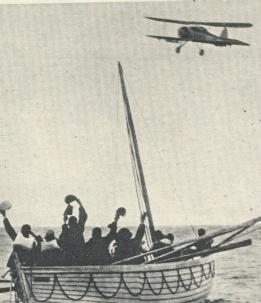
Part of the crew of the SS Fanad Head, photographed from the other lifeboat, greet a Swordfish from Ark Royal, the Swordfish was one of a group that arrived after the Skua's attacks on the U-30 and which then badly damaged the U-30 with their bombing. This photograph was taken by Geoffrey Halnan. His photographs were taken from HMS Tartar to the Ark Royal to be developed.
The bow of the U-30 had been damaged during the final successful attempt to rescue the boarding party - just how is unclear. In any event, the forward torpedo tubes were out of action, which is why a stern tube had to be used to sink the Fanad Head. The U-30 was then repeatedly attacked by depth charges from the two destroyers and Swordfish aircraft. These attacks caused leaks in the aft torpedo tubes and the U-boat became stern-heavy. The crew of the U-30 managed to stop the leaks and correct the list by carrying water to the bow in buckets. Three of the boarding party had been injured in the Skua attacks, Oblt Z S Hinsch and Masch Ob Gefr Ohse were only slightly injured but Masch Mt Adolf Schmidt had been severely wounded with an artery in his forearm severed. The submarine was able to surface that night and then sailed North. A radio message was sent to Germany which told the names of the pilots and the missing observers. The notorious voice of "Germany calling", Lord Haw-Haw, gave out the news that a German submarine had "shot down" two British aircraft, he then said that the two pilots had been rescued, but gave the names of the two observers, P.O. Simpson and P.O. McKay. This mix-up gave rise to obvious distress for the families of the men concerned.
The U-30 sailed for Iceland. By radio, it was able to alert the German consul in Iceland and on the 19th of September Off Masch Mt Adolf Schmidt was transferred to a German steamer interned in Reykjavik harbour (an officer from the steamer went aboard the U-30 as a replacement). The submarine then headed for Germany, taking 8 days to limp towards home, before breaking down and having to be towed into Wilhelmshaven. During this time Lts Thurston and Griffiths were well treated by Lemp, the U-boat commander. His treatment of Thurston, who was suffering from his burns was particularly praiseworthy. One of the German officers voluntarily gave up his bunk, and to stop Thurston from being knocked when the crew rushed to battle stations a man was detailed to stay at his bedside and keep him "tucked in". However, once they arrived in Germany the treatment was entirely different. The Gestapo arrived when Lemp was having a farewell drink with the two prisoners, they snatched the drinks from their hands and rounded on Lemp for drinking with the enemy.
In the First World War, the sinking of the Liner Lusitania had helped bring the Americans into the war, and the sinking of the American liner Athenia threatened to do the same thing again (Lemp had almost certainly attacked the Athenia by mistake, thinking her to be a cruiser). The Nazi propaganda ministry had flatly denied any involvement by the Germans in the sinking and suggested that it was a deliberate act by the British to bring the Americans into the war. The Nazis were to push this incredible lie even further when they sent a warning to the USA that Britain was planning to blow up the American liner Iroquois. Now Lemp arrived back in Germany with two prisoners who had learnt about the U-30's involvement. Thurston and Griffiths were therefore kept as political prisoners, the British government (and by default the men's families) were not informed of their capture and they were imprisoned with high-ranking Polish officers at a camp in Brunswick (all of the Polish officers were later murdered by the Gestapo). In error, some shot-down RAF crew were put into their company. Griffiths asked one of these men to let him pretend to be him, writing a letter in his name but in Griffiths' handwriting and addressing it to Griffiths' wife. She realised straight away that he must still be alive and the matter was raised by the Red Cross, who got Griffiths and Thurston recognised as POWs and moved to a proper POW camp. Along with other Royal Navy pilots they were in a tunnel escape attempt in 1941 but were recaptured. Guy Griffiths escaped again in the closing months of the war. After some amazing adventures, he arrived back in England on VE day. Being regular officers both Thurston and Griffiths stayed in the service after the war. Sadly Thurston was killed in an accident while flying a Seafire fighter.
Fritz Lemp, who showed such compassion to the passengers and crew of the Fanad Head and his two captives, has often been demonised for his role in the sinking of the Athenia. In 1941 he was killed while in command of the U-110 during its encounter with HMS Broadway, the incident which secured some Enigma machine codes for the British. Masch Mt Schmidt, the submarine crewman who was put ashore in Iceland, was later taken prisoner when Britain took control of the country after the fall of Denmark, and he was sent to a Canadian POW camp. After the war, Schmidt's testimony was used at the Nuremberg war trials to expose the true story of the sinking of the Athenia and the German cover-up.
After the Fanad Head incident, the Ark Royal spent the next two days conducting searches of the ocean around Rockall in the hope of finding the missing Skua crews. It then anchored at Loch Ewe, Scotland. The First Lord of the Admiralty, Winston Churchill, came over from Scapa Flow on the Battleship Nelson for an inspection on the 17th of September. With all the crew mustered on deck, the aircrews who had taken place in the incident were paraded one step forward. Churchill happened to first pick on the pilot of the Swordfish who had dropped his bombs on a false target. Churchill asked "What did you do?" and the unfortunate pilot explained what had happened. The great man fixed him with a withering look and said, "Bloody Fool". Some years later, the same pilot was serving at a remote landing ground in the Western Desert when a transport aircraft with an escort of Spitfires landed. Out stepped Winston Churchill, now PM, in need of a toilet. It fell to the pilot to drive him to the very primitive facilities. After he had finished his ablutions and was about to get back on the aircraft Churchill, with a twinkle in his eye, turned and said "You were the bloody fool who failed to give me my first naval victory of this war. Weren't you?". The pilot smartly saluted and said, "Yes, Sir!" ³
Seventy Years after the incident, a fishing boat from the Black Isle fishing near Rockall bought a Skua propellor to the surface in its nets. For some years it was on view at the Highland Aviation Museum near Inverness (now sadly closed).
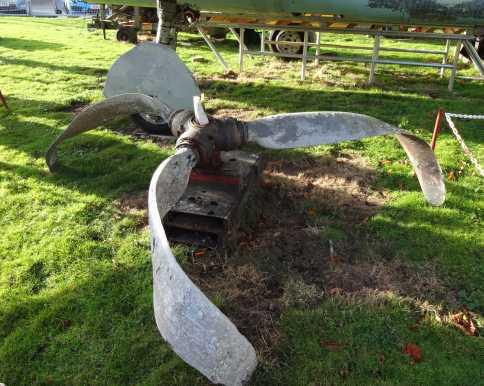
The Skua propellor as it used to be displayed at the Highland Aviation Museum near Inverness Airport.
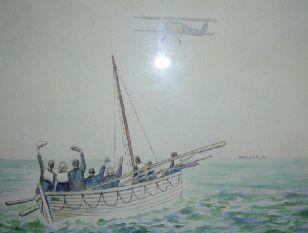
This painting, obviously based on the photos taken by Geoffrey Halnan (see above), was painted for Fred Hill, cook on the Fanad Head. He was 62 at the time and he sustained an injury to his leg during the incident that stopped him from going back to sea. Fred Hill is the fourth from the left in the painting. It may well have been the smell of Fred's freshly baked bread that made the German boarding party spend so long gathering provisions from the ship. Fred Hill died in 1965 at the age of 88. The photo of the painting that belonged to Fred is courtesy of Tom Brown, a relative of Fred.
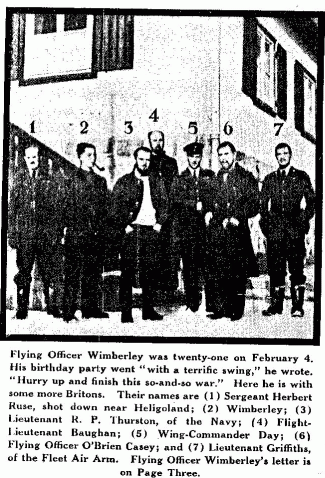
A copy of a newspaper cutting kindly sent me by Jean Kathleen Tinkler, daughter of P.O. James Simpson, one of the Skua observers killed in the incident. It Shows Lt R.P. Thurston (3) and Lt G.B.K. Griffiths (7) as P.O.Ws in Germany.

Jean Kathleen Tinkler, daughter of P.O. James Simpson, also kindly sent me this copy of the letter sent to her mother to inform the family of their father's death. The secrecy surrounding this incident is evident. James Simpson was one of the first casualties of the war and yet his family could not find out any details about the facts of his death or even discuss the matter with anyone else.
The Question of Those Bombs
Many accounts of the Fanad Head incident give a range of reasons why the blast of their bombs bought the Skuas down. There is often a suggestion that the bombs were in some way incorrectly fused. We will almost certainly never know the real reason, but here are the facts as I understand them. The Skuas were carrying two types of bombs that day; four of the small 24 lb (11 kg) Cooper bombs and one of the bigger 100 lb (45 kg) anti-submarine (AS) bombs. The Cooper bombs would explode on impact, either with water or a hard surface such as a submarine. The 100lb AS bomb had a fuse that was supposed to go off immediately if the bomb struck a hard surface, such as a direct hit on the submarine, or have a 2-second delay if it struck the water, in theory, this would allow it to sink to 25 feet (7.6 metres) the optimum depth for its explosion to sink a crash-diving submarine. To my understanding none of these settings was adjustable, so in my mind, there is no way the bombs could be said to have been fused wrongly. When you understand that the Skuas were not dive-bombing, but delivering their bombs in attacks from only a few metres above the sea (see Guy Griffiths painting of his attack above) then it would seem highly likely that it was simply a mixture of inexperience of using live bombs and determination to sink the enemy submarine before it could crash-dive that caused the pilots to release their bombs at too low an altitude. Certainly, being dropped so low, the delayed AS bomb may well have done a "bouncing bomb" act and skipped into the air to explode close behind the Skuas. It seems that aircrew were not briefed on this possibility, and had certainly had no live training on dropping the AS bomb which, even though the early versions had started to be tested in 1931, had not been put into production until 1938 and was considered a "secret weapon" at the start of the war. In fact, full testing of the anti-submarine bomb was still ongoing when its development was "frozen" to get it into production due to the threat of war breaking out. Only a week earlier (5th September) a Coastal Command Avro Anson of 223 Squadron using the same sort of bomb had been destroyed by the bombs skipping into the air to explode close behind the aircraft. Happily, in that case, the crew were saved and thankfully their target also escaped, because it was the Royal Navy Submarine HMS Seahorse that had been attacked by mistake. The 100 lb AS bomb proved to be a very unsatisfactory weapon in other respects. It is reckoned that 40% of those dropped did not explode. Its explosive power was not enough to crack the hull of a submarine (a direct hit was scored on U-46 but it still survived) The only submarine to be sunk by the 100 lb AS bomb was the U-64, struck by two simultaneous hits while at anchor during the second naval battle of Narvik (even that is disputed ⁴). The Fleet Air Arm and Coastal Command both switched to using depth charges, set off by a pressure fuse at the prescribed depth rather than a time-delay. It should be noted that Hanson and Campbell had the longest time to properly judge their attack (even though it turns out they were not actually attacking the submarine) and therefore probably released their bombs from a slightly higher altitude, their AS bomb did not explode at all, and yet when they got back to Ark Royal they still found shrapnel from the 24 Ib bombs in their Skua. It is worth noting that in his official report of the incident, delivered straight after the events, the Ark Royal's commander Vice Admiral Lionel Wells strongly recommended that the standard Navy depth charge be adapted for dropping from aircraft as a matter of urgency. On balance, I think the most likely explanation is that the Skuas simply dropped their bombs from too low an altitude, but they did it in that proud Nelson tradition of "engage the enemy more closely".

100 lb (45 Kg) anti-submarine bomb (Mk IV) on display at the RAF Museum, Hendon. Once the predilection to skip across the water was identified the Mk III and MkIV versions of the bomb were built to accept a screw-on concave "cup" facing forward on the nose to prevent them ricocheting. Later marks had the cup welded on as a permanent feature. This might have slightly reduced the risk to the aircraft dropping the bomb but it still remained a wholly ineffective weapon.
Notes.
¹ "Cooper bombs" is the name usually associated with these small bombs in modern texts, they were in use from World War One, throughout the inter-war years and in the early years of World War Two. But in contemporary documents, they are often referred to as "Cupar" or "Coupar" bombs. In his book "Skua!" Peter C Smith speculates that the name derived from the bombing range at Cupar in Scotland. They are often referred to as "20 lb Cooper bombs", even though they actually weighed 24 lb.
² Many published sources mistakenly place McKay in Thurston's aircraft and Simpson with Griffiths. Notes written by Griffiths and lodged with the Royal Marines Museum at Eastny clearly state McKay was in Griffiths' aircraft and Simpson was with Thurston (copies of the notes were given to me by Geoffrey Halnan). At this stage of the war, the title "Observers Mate" was applied to non-commissioned observers to distinguish them from officer "Observers". Later the term "Rating Observer" was used instead. The term "Observer" in the Royal Navy Air Branch essentially meant someone trained in navigation, but also trained to recognise and classify friendly and enemy ships and also able to spot and correct the fall of naval guns. For most of the Skua's operational career, the man in the rear seat of most Skuas would be a Telegraphist/ Air Gunner (TAG). A TAG was not trained in navigation, instead his skills were in air gunnery and operating the radio equipment (but that radio equipment could guide the aircraft back to the carrier). It was unusual for an entire formation of Skuas to have a navigator on board every aircraft, which underlines the intention for the Skuas to split up and search for the Fanad Head independently.
³ The report of the first Swordfish pilot to attack the U-30 and the subsequent encounters with Churchill were in a typed letter sent to Geoffrey Halnan by Lt Cdr H.J.M. "Mick" Lawrence MBE, RD, RNR. I had assumed that Lawrence himself was the pilot in question and for a few years this website attributed the action to him. However, it turns out the letter was merely forwarded on from Mick Lawrence, who was not a pilot himself, so the actual name of the pilot is unknown. I can only apologise to the family of Lt Cdr Lawrence, who sadly died on 2nd January 2009. Unfortunately the error was repeated in Mike Rossiter's 2006 book "Ark Royal".
⁴ The sinking of the German submarine U-64, by bombs dropped from a Fairey Swordfish during the Second Naval Battle of Narvik, is usually attributed to 100 lb (45 kg) AS bombs; some wartime accounts even claimed that one of the bombs went through the hatch in the submarine's conning tower! Other accounts say that the bombs the Swordfish dropped were the larger 250 lb (113 kg) GP bomb or even 350 lb (159 kg) depth charges (although it is generally accepted that the 350 lb depth charge only became available the following year). The best account can be found in Geirr H Haarr's "The German Invasion of Norway" (see bibliography).
Further Reading
Magne Haugsend (author of "The SS City of Flint - An American Freighter at War") has researched and written a magnificent article "The sinking of the Athenia, 3 September 1939, and the fate of the U-boat that fired the torpedo". It was published in the Summer 2022 (Vol XXXIII No 133) edition of the Journal of the Military History Society of Ireland. It goes into much greater detail about what happened to the U-30 and in particular the story of Adolf Schmidt, the injured crewman left in Iceland. The Military History Society of Ireland website can be found at <this link>.
A Note on Sources...
Most of the sources for the story on this page were collected over the years by Geoffrey Halnan. They include recollections of the events by the Halnan family and the photos Geoffrey himself took, also correspondence from "Guy" Griffiths, Dennis Campbell, Mick Lawrence, and the transcript of the log of the U-30. I was also helped with some additional information from combat reports forwarded to me by the American historian Mark Horan.
The Four Ark Royals: By Micheal Apps, ISBN 0 7183 0344X has a brief overview of the Fanad Head incident along with other details of the use of Skuas. The actual description of the incident in the book is incorrect, giving the impression all three Skuas arrived at the same time and dive-bombed the submarine (this description of events is inevitably found in most published works that mention the events of that day). However, the book does contain the transcript of a wartime letter from Lieutenant Guy Griffiths to the Red Cross in Geneva, which gives a true account of events as he observed them. The book also contains some of the photos taken by Geoffrey Halnan.
Aircraft Versus Submarine in Two World Wars: By Dr Alfred Price ISBN 1 84415 091 7, gives the best rundown on the development and use of the 100 lb anti-submarine bomb.
British Explosive Ordinance - NAVORD OP 1665: A US Navy document detailing the types of bombs used by the British, it gives a much better technical description of the 100 lb AS bomb than any British document I've ever found.
About the Fanad Head on U boat net (includes nice photo of the ship)
Log entries for HMS Ark Royal on the Naval-History Net website.
About the U30 on U boat net
About Fritz Lemp on U boat net
About the sinking of the Athenia on U boat net
Pictures of Cooper bombs
Log entries for HMS Ark Royal on the Naval-History Net website.
About the U30 on U boat net
About Fritz Lemp on U boat net
About the sinking of the Athenia on U boat net
Pictures of Cooper bombs
